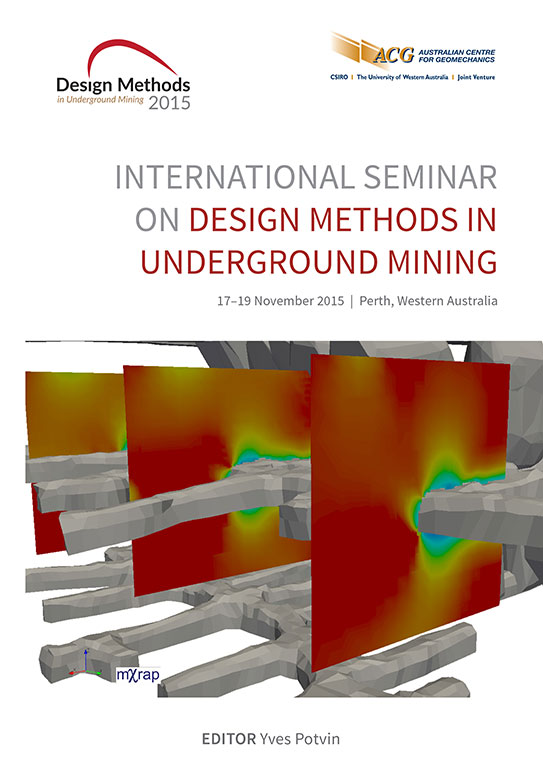Seismic hazard assessment using apparent stress ratio

|
Authors: Brown, LG; Hudyma, MR; Turcotte, P |
DOI https://doi.org/10.36487/ACG_rep/1511_04_Brown
Cite As:
Brown, LG, Hudyma, MR & Turcotte, P 2015, 'Seismic hazard assessment using apparent stress ratio', in Y Potvin (ed.), Design Methods 2015: Proceedings of the International Seminar on Design Methods in Underground Mining, Australian Centre for Geomechanics, Perth, pp. 123-134, https://doi.org/10.36487/ACG_rep/1511_04_Brown
Abstract:
Seismically active operations require special considerations for design and mining practices in order to mitigate the risk associated with large and potentially damaging seismic events. When detailed knowledge of the local rock mass conditions and the historical seismic response is considered during mine design, costly rehabilitation and time delays can be minimised. High apparent stress is an indicator of increasing stress within the rock mass. Apparent stress ratio (ASR) is a new and innovative way of quantifying apparent stress for a given seismic population. A high ASR value suggests that local stress conditions are high and increasing. Analysis of seismic event data from LaRonde Mine, Canada, suggests that the ASR is strongly correlated with the occurrence of large events — high seismic hazard. This paper presents the use of ASR as a precursory trend to large seismic events for both intermediate and long term seismic hazard. Practical examples are provided from LaRonde Mine.
References:
Brown, LG 2015, ‘Seismic hazard evaluation using apparent stress ratio for mining-induced seismic events’ Masters thesis, Laurentian University.
Butler, AG 1997, ‘Space–time clustering of potentially damaging seismic events and seismic viscosity in Western Deep Levels East and West Mines’, in SJ Gibowicz & S Lasocki (eds), Rockbursts and Seismicity in Mines, Balkema, Rotterdam, pp. 89-93.
Harris, PC & Wesseloo, J 2015, mXrap v5 software, Australian Centre for Geomechanics, The University of Western Australia,
Mendecki, AJ 1993, ‘Real time quantitative seismology in mines’, in RP Young (ed.), Proceedings of the Third International Symposium on Rockbursts and Seismicity in Mines, Balkema, Rotterdam, pp. 287-295.
Mercier-Langevin, F 2010, ‘LaRonde Extension – mine design at three kilometres’, in M Van Sint Jan & Y Povtin (eds), Proceedings of the Fifth International Seminar on Deep and High Stress Mining (Deep Mining 2010), Australian Centre for Geomechanics, Perth, pp. 3-15.
Nuttli, OW 1973, ‘Seismic wave attenuation and magnitude relations for Eastern North America’, Journal of Geophysical Research, vol. 78, pp. 876-885.
Plouffe, M 1992, Preliminary local magnitude scales for mining-induced seismicity at some mines in the Sudbury Basin, Mining Research Laboratories, Canada.
Richter, CF 1935, ‘An instrumental earthquake magnitude scale’, Bulletin of the Seismological Society of America, vol. 25, pp. 1-32.
Van Aswegen, G 2005, ‘Routine seismic hazard assessment in some South African mines’, in Y Potvin & M Hudyma (eds), Proceedings of the Sixth International Symposium on Rockbursts and Seismicity in Mines (RaSiM6), Australian Centre for Geomechanics, Perth, pp. 437-444.
Wyss, M & Brune, JN 1968, ‘Seismic moment, stress and source dimensions for earthquakes in the California-Nevada region’, Journal of Geophysical Research, vol. 73, pp. 4681-4694.
Young, D 2012, Energy variations in mining-induced seismic events using apparent stress’ Masters thesis, Laurentian University.
© Copyright 2025, Australian Centre for Geomechanics (ACG), The University of Western Australia. All rights reserved.
View copyright/legal information
Please direct any queries or error reports to repository-acg@uwa.edu.au
View copyright/legal information
Please direct any queries or error reports to repository-acg@uwa.edu.au